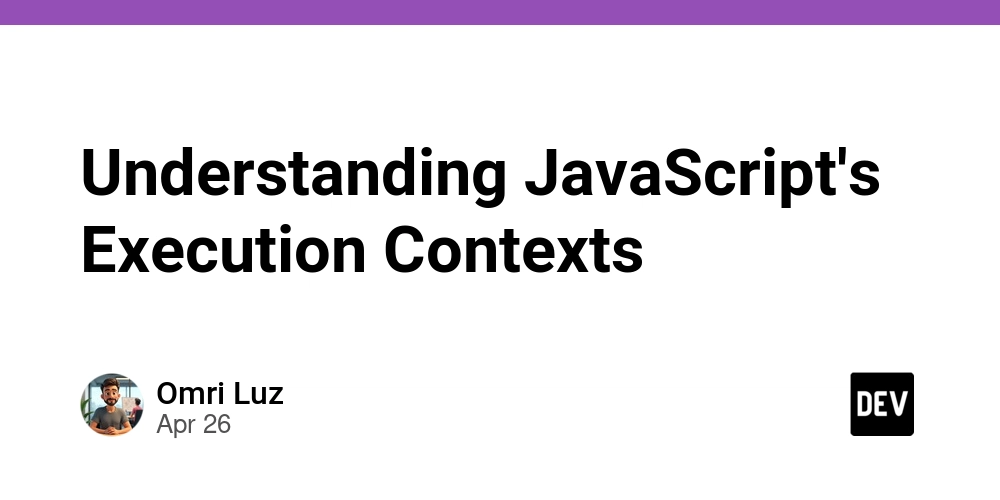Understanding JavaScript's Execution Contexts
Understanding JavaScript's Execution Contexts: An Exhaustive Guide JavaScript, a high-level programming language widely adopted for web development, operates under an intricate model of execution contexts. Understanding these contexts is pivotal for mastering the nuances of JavaScript, as they dictate how and when code is executed, how variable scope is determined, and how this interacts with functions and the broader environment. This article aims to furnish senior developers and advanced practitioners with a comprehensive exploration of JavaScript's execution contexts, while analyzing historical developments, performance considerations, debugging techniques, and real-world applications. Historical and Technical Context The Evolution of JavaScript JavaScript was developed in 1995 by Brendan Eich during his tenure at Netscape Communications Corporation. Initially named Mocha, then LiveScript, it has evolved significantly over the years, leading to the standardized ECMAScript (ES). The introduction of ES5 (2009) and ES6 (2015) brought substantial enhancements, including the introduction of modern features such as let/const, arrow functions, classes, and promises. Each of these features has intertwined with the execution context paradigm. What is an Execution Context? An execution context in JavaScript encompasses the environment within which the JavaScript code is executed. It defines the scope of variables, the value of this, and manages the hoisting mechanism. We can categorize execution contexts into three primary types: Global Execution Context: Created when a JavaScript program starts executing. Only one global context exists per JavaScript application. Holds variables, functions, and the global object (e.g., window in browsers). Variables declared as var in the global context become properties of the global object. Function Execution Context: Created whenever a function is invoked. Each invocation of a function creates a new context. Holds the function's local variables, this binding, and the arguments received. Each context can access variables from its parent contexts (i.e., lexical scope). Eval Execution Context: Created when code is executed within the eval function, though usage of eval is generally discouraged due to performance and security concerns. Each context consists of three key components: Variable Object (VO): Contains function parameters, variables, and declared functions. Scope Chain: Maintains the links to the variable objects of parent execution contexts, enabling variable resolution. this Binding: Reference to the function context in which the currently executing code resides. Understanding the Lifecycle of Execution Contexts The lifecycle of an execution context includes: Creation Phase: The JavaScript engine prepares the execution context, where memory allocation for variables occurs. Hoisting takes place, where variable declarations (but not initializations) are moved to the top of their scope. Execution Phase: The engine executes the code line by line, assigning values to variables and performing operations as per the instructions. Code Examples: Complex Scenarios To illustrate execution contexts, we will explore a series of complex examples. Example 1: Variable Scope and Hoisting function outerFunction() { var outerVar = 'I am outside!'; function innerFunction() { console.log(outerVar); // Closure: Accesses variable from outer context var innerVar = 'I am inside!'; } innerFunction(); console.log(innerVar); // ReferenceError: innerVar is not defined } outerFunction(); Explanation: In this example, innerFunction can access outerVar due to closure, while innerVar is inaccessible outside its own lexical scope. Example 2: this Binding in Different Contexts const obj = { name: 'Alice', greet: function() { console.log(`Hello, ${this.name}!`); } }; obj.greet(); // Outputs: "Hello, Alice!" const greetFunc = obj.greet; greetFunc(); // Outputs: "Hello, undefined!" - `this` refers to global object (or undefined in strict mode) Explanation: When greetFunc is called as a standalone function, this does not point to obj, resulting in an undefined output. Using call, apply, or bind would resolve this: greetFunc.call(obj); // Outputs: "Hello, Alice!" Advanced Example: Closures and Factory Functions function makeCounter() { let count = 0; // This variable is preserved in the closure return function() { count += 1; return count; }; } const counterA = makeCounter(); console.log(counterA()); // 1 console.log(counterA()); // 2 const counterB = makeCounter(); console.log(counterB()); // 1 Explanation: The count variable exists within the scope of the returned function, demonstrating a closure. Each call to makeCounter creates a separate execution context, and thus, separate cou

Understanding JavaScript's Execution Contexts: An Exhaustive Guide
JavaScript, a high-level programming language widely adopted for web development, operates under an intricate model of execution contexts. Understanding these contexts is pivotal for mastering the nuances of JavaScript, as they dictate how and when code is executed, how variable scope is determined, and how this interacts with functions and the broader environment. This article aims to furnish senior developers and advanced practitioners with a comprehensive exploration of JavaScript's execution contexts, while analyzing historical developments, performance considerations, debugging techniques, and real-world applications.
Historical and Technical Context
The Evolution of JavaScript
JavaScript was developed in 1995 by Brendan Eich during his tenure at Netscape Communications Corporation. Initially named Mocha, then LiveScript, it has evolved significantly over the years, leading to the standardized ECMAScript (ES). The introduction of ES5 (2009) and ES6 (2015) brought substantial enhancements, including the introduction of modern features such as let/const, arrow functions, classes, and promises. Each of these features has intertwined with the execution context paradigm.
What is an Execution Context?
An execution context in JavaScript encompasses the environment within which the JavaScript code is executed. It defines the scope of variables, the value of this, and manages the hoisting mechanism. We can categorize execution contexts into three primary types:
-
Global Execution Context:
- Created when a JavaScript program starts executing.
- Only one global context exists per JavaScript application.
- Holds variables, functions, and the global object (e.g.,
windowin browsers). - Variables declared as
varin the global context become properties of the global object.
-
Function Execution Context:
- Created whenever a function is invoked.
- Each invocation of a function creates a new context.
- Holds the function's local variables,
thisbinding, and the arguments received. - Each context can access variables from its parent contexts (i.e., lexical scope).
-
Eval Execution Context:
- Created when code is executed within the eval function, though usage of eval is generally discouraged due to performance and security concerns.
Each context consists of three key components:
- Variable Object (VO): Contains function parameters, variables, and declared functions.
- Scope Chain: Maintains the links to the variable objects of parent execution contexts, enabling variable resolution.
- this Binding: Reference to the function context in which the currently executing code resides.
Understanding the Lifecycle of Execution Contexts
The lifecycle of an execution context includes:
-
Creation Phase:
- The JavaScript engine prepares the execution context, where memory allocation for variables occurs.
- Hoisting takes place, where variable declarations (but not initializations) are moved to the top of their scope.
-
Execution Phase:
- The engine executes the code line by line, assigning values to variables and performing operations as per the instructions.
Code Examples: Complex Scenarios
To illustrate execution contexts, we will explore a series of complex examples.
Example 1: Variable Scope and Hoisting
function outerFunction() {
var outerVar = 'I am outside!';
function innerFunction() {
console.log(outerVar); // Closure: Accesses variable from outer context
var innerVar = 'I am inside!';
}
innerFunction();
console.log(innerVar); // ReferenceError: innerVar is not defined
}
outerFunction();
Explanation: In this example, innerFunction can access outerVar due to closure, while innerVar is inaccessible outside its own lexical scope.
Example 2: this Binding in Different Contexts
const obj = {
name: 'Alice',
greet: function() {
console.log(`Hello, ${this.name}!`);
}
};
obj.greet(); // Outputs: "Hello, Alice!"
const greetFunc = obj.greet;
greetFunc(); // Outputs: "Hello, undefined!" - `this` refers to global object (or undefined in strict mode)
Explanation: When greetFunc is called as a standalone function, this does not point to obj, resulting in an undefined output. Using call, apply, or bind would resolve this:
greetFunc.call(obj); // Outputs: "Hello, Alice!"
Advanced Example: Closures and Factory Functions
function makeCounter() {
let count = 0; // This variable is preserved in the closure
return function() {
count += 1;
return count;
};
}
const counterA = makeCounter();
console.log(counterA()); // 1
console.log(counterA()); // 2
const counterB = makeCounter();
console.log(counterB()); // 1
Explanation: The count variable exists within the scope of the returned function, demonstrating a closure. Each call to makeCounter creates a separate execution context, and thus, separate count values.
Edge Cases and Advanced Implementation Techniques
Temporal Dead Zone and let/const
With ES6, let and const introduced the concept of Temporal Dead Zone (TDZ). Attempting to access them before declaration within their block scope results in a ReferenceError.
function testTDZ() {
console.log(x); // ReferenceError: Cannot access 'x' before initialization
let x = 3;
}
testTDZ();
Using this in Arrow Functions
Arrow functions do not define their own this context but inherit it from the surrounding lexical context:
const person = {
name: 'Bob',
greet: function() {
const inner = () => console.log(`Hello, ${this.name}!`);
inner();
}
};
person.greet(); // Outputs: "Hello, Bob!"
Performance Considerations and Optimization Strategies
Avoid Unnecessary Closures: While closures are powerful, excessive use can lead to memory leaks, as they hold references to their outer contexts. Use them judiciously.
Use
letandconstWisely: Whilevarallows function-wide scope,letandconstare block-scoped and can enhance performance by limiting the lifetimes of variables.Avoid Global Variables: Global variables can introduce namespace collisions and lead to bugs. Encapsulating variables and functions within modules can mitigate this.
Optimize Function Calls: Frequent function calls can be costly. Use lazy initialization and debouncing techniques to minimize execution.
Potential Pitfalls and Advanced Debugging Techniques
Understanding the Value of
this: Misunderstanding context can lead to bugs that are hard to trace. Useconsole.log(this)strategically to understandthisreferences during function execution.Performance Profiling: Utilize tools like Chrome DevTools for performance profiling. Monitor memory usage and execution contexts to optimize code.
Strict Mode: Enable strict mode using
"use strict";at the beginning of your scripts or functions. This can catch common coding mistakes and prevent unsafe actions.
Conclusion: Mastering Execution Contexts
JavaScript's execution contexts are foundational concepts that dictate how code is executed and how variable scope is managed. By grasping the intricacies of execution contexts, senior developers can write more efficient, maintainable, and robust applications.
References and Further Reading:
- MDN Web Docs on Execution Contexts
- JavaScript: The Definitive Guide by David Flanagan
- You Don't Know JS (book series) by Kyle Simpson
- ECMAScript Language Specification - MDN
By understanding the evolution, mechanisms, and implications of execution contexts, developers can enhance both performance and maintainability in their JavaScript codebases. This knowledge transcends mere syntax and transforms code into a finely-tuned instrument of interactivity and functionality.


































































































































































![[The AI Show Episode 143]: ChatGPT Revenue Surge, New AGI Timelines, Amazon’s AI Agent, Claude for Education, Model Context Protocol & LLMs Pass the Turing Test](https://www.marketingaiinstitute.com/hubfs/ep%20143%20cover.png)






























































































































![[DEALS] Koofr Cloud Storage: Lifetime Subscription (1TB) (80% off) & Other Deals Up To 98% Off – Offers End Soon!](https://www.javacodegeeks.com/wp-content/uploads/2012/12/jcg-logo.jpg)






















![Is this too much for a modular monolith system? [closed]](https://i.sstatic.net/pYL1nsfg.png)



















































































































_roibu_Alamy.jpg?width=1280&auto=webp&quality=80&disable=upscale#)














































































































![M4 MacBook Air Drops to Just $849 - Act Fast! [Lowest Price Ever]](https://www.iclarified.com/images/news/97140/97140/97140-640.jpg)
![Apple Smart Glasses Not Close to Being Ready as Meta Targets 2025 [Gurman]](https://www.iclarified.com/images/news/97139/97139/97139-640.jpg)
![iPadOS 19 May Introduce Menu Bar, iOS 19 to Support External Displays [Rumor]](https://www.iclarified.com/images/news/97137/97137/97137-640.jpg)



































































































